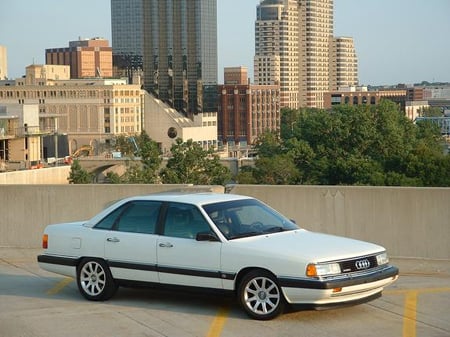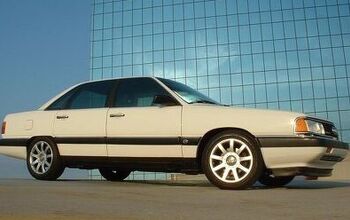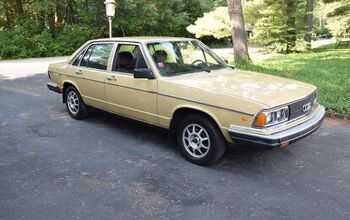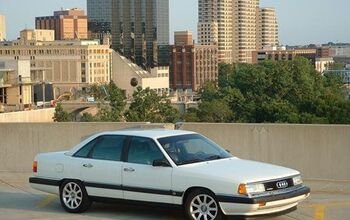In Defense of: The Audi 5000

[Update: this article has been updated and re-published here]
When I first heard about the Audi “sudden unintended acceleration” segment on CBS’s 60 Minutes in 1986, I knew immediately that they were blowing smoke. Literally.
A few years earlier, I was part of a TV crew shooting an educational program. Legendary race-car driver Parnelli Jones was the guest celebrity. The producer offered to take us to lunch in his 1976 Cadillac Fleetwood Brougham. We hopped in. Parnelli took the wheel.
Parnelli fired up the Caddy’s big V8, dropped it in gear and floored it- with his other foot on the brake. The left rear wheel lit up in a screeching howl; the car was soon engulfed in a cloud of acrid smoke. The Caddy didn’t move an inch- obviously. And neither did Parnelli, glancing at the wincing producer with his wicked grin. I had assumed (wrongly) that race-car drivers grew up eventually.
The experience seared in a lesson in basic automobile physics: brakes are always more powerful than engines, even when they have 500 cubic inches (8.2 liters). Too bad we didn’t have our cameras running. We could have made a graphic rebuttal to 60 Minutes’ fraudulent destruction of Audi.
Let’s set the scene. It’s 1984. Audi sales had shot up 48 percent on the strength of their new aero-dynamic 5000, the hot new weapon in the perpetually-escalating suburban driveway status war. It was a stunning piece. Audi was on a roll.
Suddenly, the war turned bloody. Moms in runaway Audi 5000’s were mowing down their little kids in the driveway and pinning granny against the far garage wall.
This hadn’t happened with the Olds Cutlass Supreme Coupe, the “hot” suburban car Mom traded in for her Audi. The German car certainly felt different. Unlike the Olds’ wide push-bar brake pedal– that some Americans still operated with their left feet– the Audi had that weird, small brake pedal, kinda’ close to the gas pedal.
And these Audis had a mind of their own. No matter how hard Mom pushed on the brake pedal, the Audi kept on going, right through the garage door. This despite the fact that the little five-cylinder mill only cranked out 130 horsepower. And the top-notch four-wheel disc brake system probably could generate well over 600 g-force horsepower.
Apparently, the brakes were failing at exactly the same moment that the gas pedal decided it had a mind of its own. Perfectly plausible, at least to the 60 Minutes crew.
About as plausible as ignoring the police report of the most dramatic victim on the show, Kristi Bradosky, who ran over her six year old son. That report said “Bradosky’s foot slipped off the brake pedal onto the gas pedal accelerating the auto.” Denial isn’t just a river.
Ed Bradley’s 17 minute “investigative report” aired on November 23, 1986. Between interviews of the teary-eyed “victims” (drivers) of unintended acceleration swearing their feet were on the brake pedal, CBS showed a clip of a driverless Audi lurching forward on its own.
Viewers didn’t see the canister of compressed air on the passenger-side floor with a hose running to a hole drilled in the transmission. An “expert” had rigged the Rube Goldberg device to shift the big Audi into drive and, like any automatic-equipped car, move forward (unless the brakes are depressed).
The clip was blatantly deceptive AND totally irrelevant. Nobody claimed driverless Audis were taking off and killing kids. Mom was always at the wheel, pushing the 5000’s “brake” pedal with all her might.
In 1989, after three years of studying the blatantly obvious, the National Highway Traffic Safety Administration (NHTSA) issued their report on Audi’s “sudden unintended acceleration problem.” NHTA’s findings fully exonerated Audi and some other implicated foreign makes.
The report concluded that the Audi’s pedal placement was different enough from American cars’ normal set-up (closer to each other) to cause some drivers to mistakenly press the gas instead of the brake. 60 Minutes did not retract their piece; they called the NHTSA report “an opinion.”
A flood of lawsuits was already washing over Audi, not to mention a tsunami of bad publicity. Audi took a questionable stance: they didn’t blame the drivers for the problem, even after the NHTSA report came out. Hey, the customer’s always right, and we sure wouldn’t want to make our American customers look stupid. Anything but that.
So the German automaker took it on the chin. Audi sales collapsed, from 74k units in 1984 to 12k by 1991. The timing added insult to injury; sales fell during the same years when Lexus arrived to battle for the hearts and wallets of America’s up-scale consumers. The Japanese autos quickly became the new suburban driveway prestige weapon.
Audi’s wanna-be-Lexus drivers launched a class action suit charging lost resale value. No wonder the brand almost abandoned the U.S. in 1993. It’s a killer market.

More by Paul Niedermeyer
Latest Car Reviews
Read moreLatest Product Reviews
Read moreRecent Comments
- Wjtinfwb Nice car and looks well cared for. The accessories are mostly for vanity, their value is in the eye of the buyer. I see zero value in them but I like bone stock if buying used. The problem this seller has is his spec is not at all unique; not a manual, no Shaker hood, attractive, but conservative color. Today, AutoTrader has 130 used 2015-2018 Challenger Hemi's with automatics available. The average price is abut 27,200 and mileage is slightly lower than this example at about 40k miles. Almost all are at dealers where a decent negotiator should be able to knock $1500-2500 off the ask. This is a 25k car, the buyer may not believe it but stats would say otherwise.
- FreedMike I don't need to know anything about this model per se, but I'd be very interested in knowing if Mazda is going to be using the tech from the PHEV CX-90/70 model - which is darned nice, by the way - on other Mazdas.
- Turbo Is Black Magic Honestly at this point Elon is more of a liability than an asset. How much does the board have to pay to just get rid of him?
- FreedMike The article touches on this fact, but the number of public EV chargers grew by over 18,000 between 2021 and 2023. https://afdc.energy.gov/fuels/electricity-infrastructure-trendsSo clearly the expansion is happening without the use of the funds in question. Not necessarily a bad thing, if you're into not using taxpayer money. Still, I'd be interested in knowing why the public money isn't being used. Are the regs overly complex or restrictive, or something like that? But in any case, EV charging IS expanding at a pretty solid rate. And as far as "...we’ve seen plenty of Republican-backed legislation targeting EV-related spending over the last couple of years" is concerned...well, yeah, there's a reason why Republicans don't like EV charging. The petroleum industry is one of the GOP's prime donors, and every charger built or EV sold represents a direct ding to their bottom line. Republicans, of course, like to put this in terms of "EVs are a woke mind virus," or some such nonsense, but the fact is that the people paying their bills don't want competition.
- 28-Cars-Later When its discontinued.

































Comments
Join the conversation
It is disheartening to see all the adulation on TV and in print, of Don Hewitt, mastermind of 60 Minutes, now that he has passed on, when thinking of all the negatives that resulted from the Audi 5000 debacle. He was a pioneer and did many good things for broadcasting. Too bad his ethics weren't as good. I have not watched 60 Minutes since (or many other expose programs as well).
[…] Here’s an example from a pretty typical remembrance of what happened, from a 2007 article written “in defense of Audi”: […]